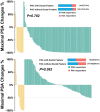The Prognostic Value of the Prostate Adenocarcinoma With Ductal Feature in Patients With Advanced Prostate Cancer Treated With Abiraterone Acetate
- PMID: 40035401
- PMCID: PMC12000715
- DOI: 10.1002/pros.24869
The Prognostic Value of the Prostate Adenocarcinoma With Ductal Feature in Patients With Advanced Prostate Cancer Treated With Abiraterone Acetate
Abstract
Background: The prognostic value of the prostate adenocarcinoma (PAC) with ductal feature in patients with advanced prostate cancer treated with abiraterone acetate has not been scrutinized. This study aims to explore the predictive value of PAC with ductal feature on the therapeutic efficacy of abiraterone therapy in metastatic prostate cancer (mPCa) patients.
Methods: We retrospectively analyzed data from 569 patients with mPCa receiving abiraterone at either the metastatic hormone-sensitive (mHSPC, N = 165) or castration-resistant prostate cancer (mCRPC, N = 404) stage. PSM was performed to balance the baseline characteristics between individuals with and without ductal features. Kaplan-Meier curves and Cox regression were used to analyze the predictive significance of ductal feature on abiraterone efficacy, including PSA response, PSA progression-free survival (PSA-PFS), radiographic progression-free survival (rPFS), and overall survival (OS).
Results: Totally, ductal feature was detected in 40/569 (7.0%) men, with 18 and 22 in the mHSPC and mCRPC cohorts, respectively. The PSA response rate was comparable for people with and without ductal features for both cohorts. Notably, in the mHSPC cohort, patients with and without ductal features shared similar median PSA-PFS (not reached vs. 32.6-months, p = 0.593) and rPFS (not reached vs. 35.0-months, p = 0.768). Similar results were observed in the mCRPC cohort (median PSA-PFS: 21.2- vs. 11.6-months, p = 0.100; median rPFS: 34.6- vs. 18.7-months, p = 0.092). COX regression further revealed that ductal feature was not an indicator of unfavorable PSA-PFS or rPFS in the mHSPC and mCRPC cohort.
Conclusion: In conclusion, our findings indicated that there is insufficient evidence to differentiate the therapeutic efficacy of AA in mPCa based on the presence or absence of ductal features. However, further validation through larger-scale studies is required to substantiate them.
Keywords: abiraterone; mCRPC; mHSPC; prostate adenocarcinoma with ductal feature.
© 2025 The Author(s). The Prostate published by Wiley Periodicals LLC.
Conflict of interest statement
The authors declare no conflicts of interest.
Figures



Similar articles
-
Predicting abiraterone efficacy in advanced prostate cancer: Insights from marker of proliferation Ki67.Prostate. 2024 Jul;84(10):932-944. doi: 10.1002/pros.24710. Epub 2024 Apr 17. Prostate. 2024. PMID: 38629249
-
Systemic immune-inflammation index predicts the combined clinical outcome after sequential therapy with abiraterone and docetaxel for metastatic castration-resistant prostate cancer patients.Prostate. 2018 Mar;78(4):250-256. doi: 10.1002/pros.23465. Epub 2017 Dec 29. Prostate. 2018. PMID: 29285775
-
Assessing the predictive value of intraductal carcinoma of the prostate (IDC-P) in determining abiraterone efficacy for metastatic hormone-sensitive prostate cancer (mHSPC) patients.Prostate. 2025 Feb;85(2):130-139. doi: 10.1002/pros.24809. Epub 2024 Oct 28. Prostate. 2025. PMID: 39465570 Free PMC article.
-
Neuroendocrine differentiation predicts the therapeutic efficacy of abiraterone and docetaxel as first-line therapy in metastatic castration-resistant prostate cancer.J Cancer Res Clin Oncol. 2023 Aug;149(10):7247-7258. doi: 10.1007/s00432-023-04639-9. Epub 2023 Mar 13. J Cancer Res Clin Oncol. 2023. PMID: 36907910 Free PMC article.
-
The heterogeneity of intraductal carcinoma of the prostate is associated with different efficacy of standard first-line therapy for patients with metastatic castration-resistant prostate cancer.Prostate. 2021 Nov;81(15):1191-1201. doi: 10.1002/pros.24215. Epub 2021 Aug 26. Prostate. 2021. PMID: 34435696 Free PMC article.
Cited by
-
Ductal Adenocarcinoma of the Prostate Presenting With Bladder Invasion and Bone Metastasis: A Case Report.Cureus. 2025 Jun 14;17(6):e86000. doi: 10.7759/cureus.86000. eCollection 2025 Jun. Cureus. 2025. PMID: 40662003 Free PMC article.
References
-
- Melicow M. M. and Pachter M. R., “Endometrial Carcinoma of Prostatic Utricle (Uterus Masculinus),” Cancer 20, no. 10 (1967): 1715–1722. - PubMed
-
- Epstein J. I., “Prostatic Ductal Adenocarcinoma: A Mini Review,” Medical Principles and Practice 19, no. 1 (2010): 82–85. - PubMed
-
- Epstein J. I., Partin A. W., Potter S. R., and Walsh P. C., “Adenocarcinoma of the Prostate Invading the Seminal Vesicle: Prognostic Stratification Based on Pathologic Parameters,” Urology 56, no. 2 (2000): 283–288. - PubMed
-
- Christensen W. N., Steinberg G., Walsh P. C., and Epstein J. I., “Prostatic Duct Adenocarcinoma. Findings at Radical Prostatectomy,” Cancer 67, no. 8 (1991): 2118–2124. - PubMed
MeSH terms
Substances
LinkOut - more resources
Full Text Sources
Medical
Research Materials
Miscellaneous

